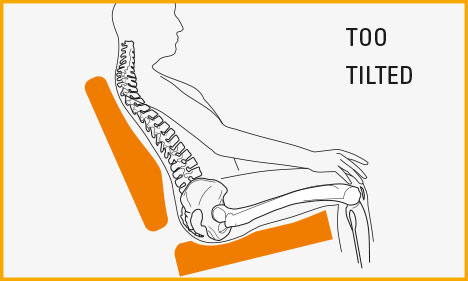Partagé:
Take it offline!
This Education in Motion resource is also available as a printable PDF.
Téléchargez PDF
Note: 90° is used as a reference only. All angles should be a direct translation of the body angles found during clinical assessment.
Thigh to Trunk Angle
Seat-to-Back Support Angle
Assessment Goals
Provide support in the most posturally aligned comfortable position. However, there may need to be compromises for supporting optimal levels of active movement for functional tasks.
Although hip range of motion (ROM) limitations are oftensuggested by a client’s seated presentation, definitive hip ROM is identified during mat assessment. In supine (with the spine in neutral alignment) hip flexion ROM is exceeded at the point when the pelvis rotates rearward.
Technical Considerations
Altering the seat to back support angle enough to accommodate client's hip ROM is necessary for optimal spinal alignment. This has to be balanced against considerations below, particularly at more extreme angles.
Greater than 90°
- Pelvis may tilt posteriorly, trunk becomes kyphotic and hips can slide forward.
- Body mass moves behind the body’s centre of gravity, client has an increased probability of sliding.
- Extensor tonal patterns may be triggered.
- Entire system may have less rearward stability
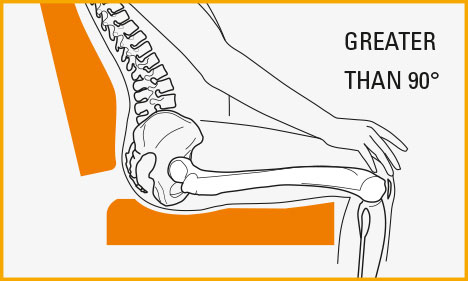
Less than 90°
- If seat-to-back support angle is less than hip flexion ROM can tolerate, the pelvis may rotate rearward and client may slide forward
- Pelvis may anteriorly rotate, so that there is a tendency to flex the trunk away from the back support and loose trunk stability
- Best combined with a seat rake or fixed tilt so that the back support is no more flexed than 90° relative to the ground, in order to provide the client with effective trunk support against the downward pull of gravity.
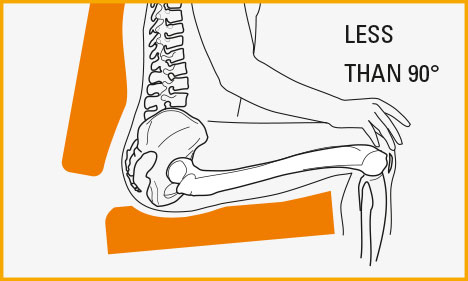
Thigh to Lower Leg Angle
Seat to Legrest Support Angle
Assessment Goals
With the pelvis in a neutral position and thighs loaded, support the lower limbs in a position which loads the feet for stability and pressure distribution. It is particularly important to accommodate ROM limitations such as the hamstring range.
Technical Considerations
Seat to legrest support angle can be altered by the hanger angle, seat depth, footplate placement on the hanger, as well as use of a calf strap or pad.
Greater than 90°
- If the thigh to lower limb angle is greater than hamstring range can tolerate (with the pelvis in neutral tilt) hamstring tightness may pull pelvis forward, tilt the pelvis into a posterior orientation and the client could slide forward.
- Can be more difficult to load feet effectively.
- A more extended legrest hanger angle creates a longer overall wheelchair profile, which increases turning circle and creates a functional barrier to getting close to objects in the environment.
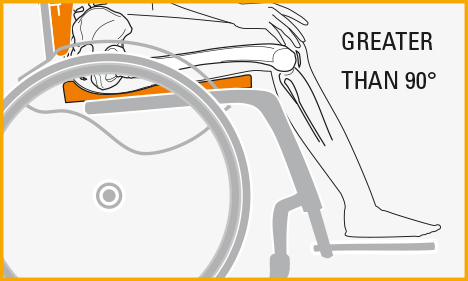
Less than 90°
- If the seat to legrest support angle is less than quadriceps range can tolerate, the pelvis may be pulled into an anterior tilted position. This can create a tendency to hyperextend the trunk and reduced trunk control.
- Requires greater ankle dorsiflexion than a 90° or extended legrest support position.
- May be more difficult to properly load feet.
- May need higher seat height to avoid caster interference.
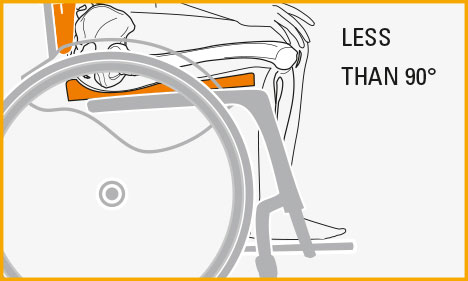
Lower Leg to Foot Angle
Foot Support Angle
Assessment Goals
With the pelvis, thighs, and lower leg in optimal alignment, maintain foot in its best position for loading. Support the feet as close to neutral as is possible for maximum surface contact and preservation of joint alignment. ROM limitations of the foot and ankle need to be accommodated.
Technical Considerations
Footplate angle
Greater than 90°
- May require higher seat height.
- Can be less stable, causing feet to slide forward
- May influence tonal patterns and abnormal reflexes.
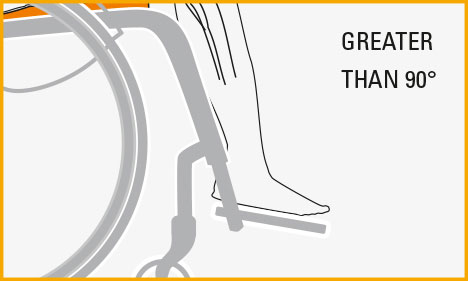
Less than 90°
- Consider stretch on Achilles tendon and available ankle ROM.
- May require higher seat height.
- May influence tonal patterns and abnormal reflexes.
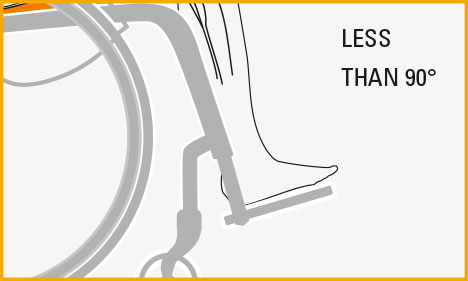
Orientation
Assessment Goals
Orient the client position in the seating/mobility system in a position that promotes an upright seating posture and a stable base for function.
Technical Considerations
Consider mobility base selection:
- Seat frame angle adjustability
- Overall length of frame
- Seat-to-floor height
- Ability to interface with seating
Vertical
- Client may be unable to hold head/trunk upright against gravity.
- Requires more effort to keep head and trunk upright, can exacerbate fatigue
- Client may have tendency to slide into up to 25° posterior pelvic tilt in an effort to achieve stability
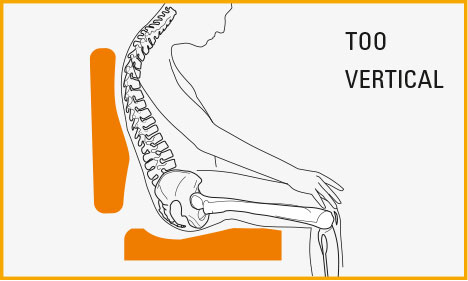
Tilted
- Client may flex forward away from backrest if has strong righting reaction
- Visual orientation may be negatively impacted.
- May have an influence on safe swallowing position
- More difficulty to engage in functional activities that require forward reaching
- 45-55 degrees of posterior tilt required for effective pressure relief to inferior pelvic area
